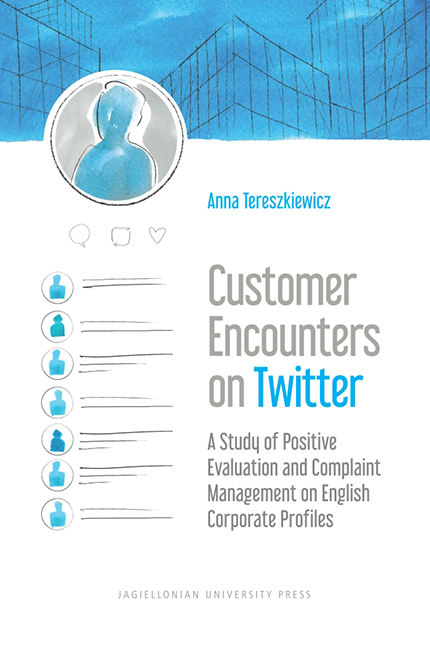 Customer Encounters on Twitter
Customer Encounters on Twitter Book contents
- Frontmatter
- Table of Contents
- Acknowledgements
- Introduction
- Chapter 1 Social media and corporate communication
- Chapter 2 Customer encounters as a genre of social interaction
- Chapter 3 Corporate profiles on Twitter – general characteristics
- Chapter 4 Positive evaluation and complaint management on Twitter
- Chapter 5 Selected politeness and lexicogrammatical properties of the tweets
- Conclusions
- References
- Frontmatter
- Table of Contents
- Acknowledgements
- Introduction
- Chapter 1 Social media and corporate communication
- Chapter 2 Customer encounters as a genre of social interaction
- Chapter 3 Corporate profiles on Twitter – general characteristics
- Chapter 4 Positive evaluation and complaint management on Twitter
- Chapter 5 Selected politeness and lexicogrammatical properties of the tweets
- Conclusions
- References
Summary
The analysis which follows focuses on customer encounters in social media. Owing to the widespread popularity of social media as a channel of corporate interaction, their extensive use among consumers as a means of electronic word-of-mouth communication and the role they play as corporate reputation management tools, it was considered interesting and important to investigate company practices in the management of online encounters. The analysis concentrates on two areas of customer interaction which are significant and/or critical for the company's reputation, i.e. positive and negative evaluation management, and aims to investigate strategies employed by English companies in the management of consumer reviews. The manner in which a company approaches such an evaluation is an important factor in determining the perception of the company by clients and may have consequences for the company's image and future relations with consumers.
More specifically, the study is devoted to customer encounters on Twitter, a microblogging platform. Twitter has been selected for analysis due to the characteristics of the medium, which may significantly impact the shape of customer encounters. The technological and medium-related factors which may influence the interaction comprise the following, among others:
– Twitter off ers access to naturally occurring exchanges;
– Twitter, in contrast to other social media, places more emphasis on distributed content than on profile construction and people (Thelwallet al. 2011). The posts published by consumers, due to their rapid and real-time nature, are said to reflect the real-time interests of users. Consumers’ messages are dynamic, spontaneous and usually genuine;
– interaction on Twitter is primarily text-based. The company's image is created mainly through the written message. The language and strategies used in the encounters, therefore, have a special commercial and strategic importance, since they are the primary determinants of the quality of service (cf. Cameron 2000b: 327-328, Jagodziński and Archer 2018);
– Twitter imposes constraints on the length of the message (140 words). Each message has to be brief or divided into several tweets;
– interactions can be conducted in synchronous and asynchronous forms. Twitter allows for both real-time and delayed communication;
- Type
- Chapter
- Information
- Customer Encounters on TwitterA Study of Positive Evaluation and Complaint Management on English Corporate Profiles, pp. 9 - 12Publisher: Jagiellonian University PressPrint publication year: 2022
